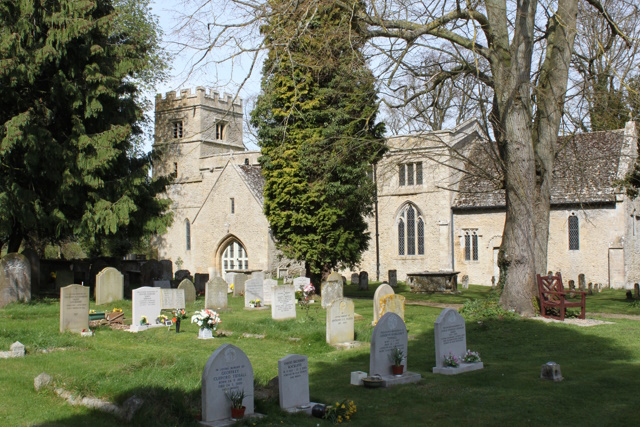


























The Church of St Mary the Virgin, Black Bourton
The Church of St. Mary the Virgin at Black Bourton was originally built about 1190. The five-bay arcade between the nave and north aisle survives from this time. In the 13th century the chancel, nave and north aisle were remodelled, and the easternmost bay of the aisle was projected northward to form a north transept. Early English Gothic lancet windows in chancel, nave and north chapel date from this time. The north doorway of the north aisle dates from the 14th century. In the 15th century the bell tower was built into the nave and the stone pulpit was built. By the end of the 16th century the north transept had become the memorial chapel of the Hungerford family. Built into the north wall is a substantial stone monument to Eleanor Hungerford (died 1592): a recumbent effigy framed by Corinthian columns. The chapel also includes an English Baroque cartouche to Anthony Hungerford (died 1703) on the west wall. Black stone plaques on the floor record other members of the family. The building was restored under the direction of the architect E.G. Bruton in 1866. During the restoration a number of late 13th century wall paintings were discovered inside the church. At the time these were whitewashed over again, but in 1932 they were uncovered again and restored. On the south wall is St Richard of Chichester with, below, the Adoration of the Magi, the Massacre of the Innocents, and the Angel appearing to St Joseph, all with foliage borders. On the north side of the nave over the arcade are paintings of the Tree of Jesse, St Christopher, the martyrdom of St Thomas Becket, the Coronation of the Virgin, the Baptism of Jesus, Saints Peter and Paul and the stoning of Saint Stephen. The church is now a Grade I listed building. By 1757 the tower had a ring of five bells including the sanctus bell. Henry I Knight of Reading cast three of them including the tenor bell in 1618–19. Henry III Bagley, who had bell-foundries at Chacombe and Witney, cast the third bell in 1743. In 1866 Mears and Stainbank of the Whitechapel Bell Foundry re-cast the second bell, which had long been cracked, and added a new treble bell. The frame is oak, was made in the late Middle Ages and by 1965 required replacement. In 1966 the tenor bell of 1619 was transferred to the parish church of St John the Evangelist in Carterton. Due to the condition of the frame the bells remaining at St Mary's were unringable until 2017, when John Taylor & Co of Loughborough restored them and added a new treble bell, increasing the ring of bells to six. St Mary's churchyard includes 32 Commonwealth War Graves Commission burials. There are 30 Second World War burials, one from the First World War and one other. Most of the Second World War graves are of members of the RAF and allied air forces from RAF Brize Norton. The Church of St. Mary the Virgin is a Grade I listed building. For more information about the listing see CHURCH OF ST MARY THE VIRGIN, Black Bourton - 1367683 | Historic England |

